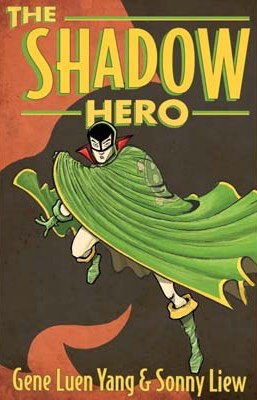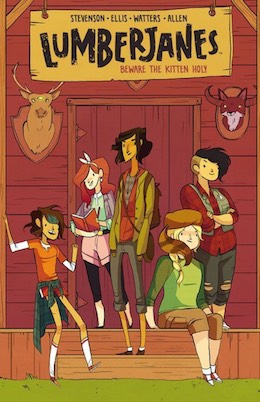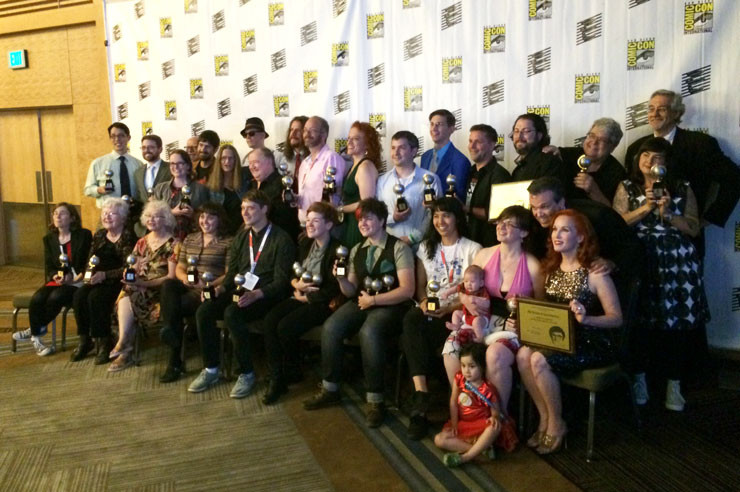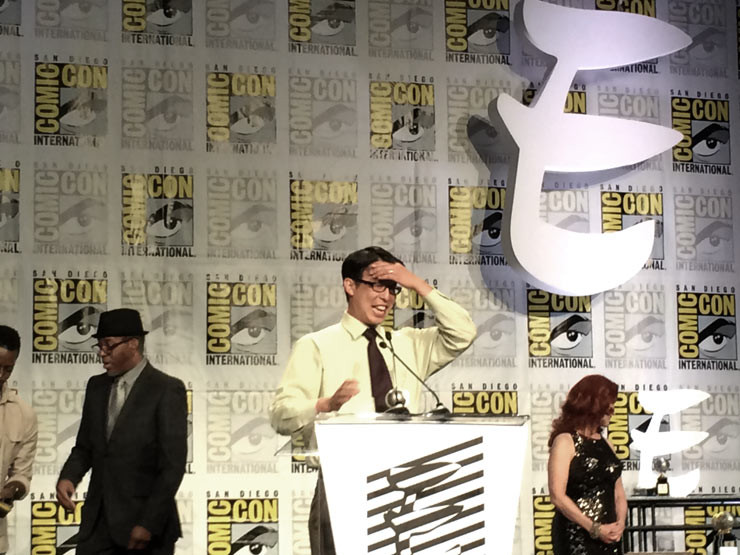“It was a crazy night. Absolutely crazy.”
Gene Luen Yang had won the Eisner Award for Best Writer.
This year’s Eisner Awards ceremony was in early July, during the 2015 Comic Con International in San Diego. The Eisners are the most prestigious, high-profile awards in the comics industry, and they’re judged in a two-tier system, with books being selected for the ballot by a small diversely-employed team of industry judges that changes every year; then everyone in every part of the comics industry—from authors to reporters to librarians to retailers to educators and professors and publishers—votes to select the winners. It’s a system that rolls up quality, popularity, and industry acclaim/appreciation into a single award—and as such, it’s a bellwether for the state of the comics industry.
Winning an Eisner says to an author: you made the comic that everyone in the industry has jointly acknowledged to be the best thing published this year. That’s heady praise—especially in light of the fact that many other book awards (like the Caldecott, the LA Times Book Prize, the National Book Award, the Newbery, and the Printz) are selected by a sole jury rather than by popular vote.
Historically, the comics industry in the US has been dominated by capes and tights—superhero comics. Those have been the comics that generate merchandise, cosplay, blockbuster movies, which dominate the New York Times Bestseller List, and yes—win the Eisner Awards. For seventeen of the past twenty-seven years of the Eisner Awards (the awards were founded in 1988), the award for Best Writer has gone to an author for their superhero comics work. Every single Eisner for Best Writer has gone to an author producing pamphlet comics—serial, monthly works—rather than graphic novels.
 This year, the award went to Gene Luen Yang—a writer who has made his name in the graphic novel industry, where he wrote and illustrated the first ever graphic novel to be a finalist for the National Book Award—and the first ever graphic novel to win the Printz Award (given by the American Library Association). His books are New York Times Bestsellers, winning praise and acclaim from schools and libraries and bookstores across the US. In winning the Eisner for Best Writer, he triumphed in a category where every single other finalist came from a background of superhero comics—and most of them were nominated specifically for their work there.
This year, the award went to Gene Luen Yang—a writer who has made his name in the graphic novel industry, where he wrote and illustrated the first ever graphic novel to be a finalist for the National Book Award—and the first ever graphic novel to win the Printz Award (given by the American Library Association). His books are New York Times Bestsellers, winning praise and acclaim from schools and libraries and bookstores across the US. In winning the Eisner for Best Writer, he triumphed in a category where every single other finalist came from a background of superhero comics—and most of them were nominated specifically for their work there.
“This change didn’t come out of nowhere, but it seemed to. It’s obvious that the diverse, graphic-novel reading audience for comics has been growing quickly, but the Eisners represented the comics industry itself—the voters—reflecting that change. For an industry that is often seen as trading in nostalgia, this was a real shift,” says Heidi MacDonald, the Publishers Weekly graphic novel reviews editor.
This industry-spanning change is apparent in other Eisners given that night, where Raina Telgemeier won the Eisner for Best Writer/Artist (the first woman ever to do so, and the only woman on the ballot this year!) for her kids graphic novel Sisters; Mariko Tamaki and Jillian Tamaki, whose graphic novel This One Summer also won the Governor Generals Prize, was an LA Times Book Prize finalist, won a Printz Honor, and was the first ever graphic novel to win a Caldecott Honor, won the Eisner for Best Graphic Album—New. And the all-female team of Shannon Watters, Grace Ellis, Noelle Stevenson, and Brooke A. Allen won the Eisners both for Best New Series and Best Publication for Teens for their magical girl summer camp adventure Lumberjanes.
“I think that a LOT of women comics creators paved the way to make this change possible. They opened the doors so wide that someone like me could feel really comfortable jumping in to a new format, in spite of having very little comics knowledge,” says Cece Bell, whose autobiographical graphic novel El Deafo won this year’s Eisner Award for Best Graphic Novel for Kids. “It might even be that having so little knowledge helped me (and other women creators who feel similarly about their comics knowledge) bring something new to the medium. Just having stories from a female perspective may still feel kind of different and fresh, since comics have been more male dominated until now. People of all genders respond to fresh stories, especially good ones—and booksellers and librarians take notice and spread the word. It’s a cool cycle, and one that ultimately benefits everyone, I hope. The best thing is that everyone in the comics world—not just women—has been so welcoming.”
Because the Eisners are industry awards, voted on by the industry, this demographic change—with more graphic novels for women and kids being recognized than ever before—could herald a transformation in the reading habits of the comics industry, away from serialized pamphlet comics and towards graphic novels. It shows that comics are truly being accepted outside of the comics store and gaining a permanent place in the bookstore and the library—where they have the opportunity to reach even more readers.
 “This year is showing a change in both the library and the comics industry,” says Robin Brenner, Teen Librarian in Brookline, editor-in-chief of No Flying No Tights, and former Eisner Awards judge. “When graphic novels were recognized earlier this year by the ALA with both Newbery honors and a Printz honor, there was a palpable sense of graphic novels moving forward another step in terms of being recognized as the remarkable, literary achievements they can be. However, given the gulf that has existed between the book publishing world and the comics publishing world, in terms of the awareness and recognition of different creators and works, I admit I was surprised and delighted to see the Eisners highlight many of the same creators and achievements. As an industry award, the Eisners reflect their voters, and the industry in the past has kept pretty close to the names and publishers they know within traditional comics. In the past this has shown a lack of awareness of the comics and graphic novels being produced outside of the traditional comics publishing world. This year, though, there was crossover, and with people like Jillian and Mariko Tamaki, Cece Bell, Raina Telgemeier, Emily Carroll, the Lumberjanes crew, and Gene Yang all recognized, the winners emphasized that whatever divides between those two publishing spheres is happily breaking down. As a librarian and a reader who’s always simply looked for the best comics from all origin points, it’s wonderful to see such barriers fading away.”
“This year is showing a change in both the library and the comics industry,” says Robin Brenner, Teen Librarian in Brookline, editor-in-chief of No Flying No Tights, and former Eisner Awards judge. “When graphic novels were recognized earlier this year by the ALA with both Newbery honors and a Printz honor, there was a palpable sense of graphic novels moving forward another step in terms of being recognized as the remarkable, literary achievements they can be. However, given the gulf that has existed between the book publishing world and the comics publishing world, in terms of the awareness and recognition of different creators and works, I admit I was surprised and delighted to see the Eisners highlight many of the same creators and achievements. As an industry award, the Eisners reflect their voters, and the industry in the past has kept pretty close to the names and publishers they know within traditional comics. In the past this has shown a lack of awareness of the comics and graphic novels being produced outside of the traditional comics publishing world. This year, though, there was crossover, and with people like Jillian and Mariko Tamaki, Cece Bell, Raina Telgemeier, Emily Carroll, the Lumberjanes crew, and Gene Yang all recognized, the winners emphasized that whatever divides between those two publishing spheres is happily breaking down. As a librarian and a reader who’s always simply looked for the best comics from all origin points, it’s wonderful to see such barriers fading away.”
Janelle Asselin, the Publisher of Rosy Press and Senior Editor at Comics Alliance, concurs. “The comics industry is broadening in terms of what counts as ‘comics’ and who is considered a viable audience. For too long, conversations about high sales in comics spoke only about the Direct Market [the distribution platform for comic bookstores] and ignored bookstore sales, for instance, which not only dismisses the importance of graphic novels and collected editions, it dismisses the people who often shop there like women and children. The fact that comics by and for women and for children are getting an increased amount of recognition in and out of the comics industry reflects the shifting boundaries of our medium. When comics for children sell hundreds of thousands more copies than the top selling superhero comic and women are becoming an outspoken demographic and creative force in comics, it only makes sense that the Eisner Awards would reflect how our industry is changing,” she says.
With graphic novels about sibling relationships, summer camp, growing up deaf, revisionary Asian-American history, and the tween experience winning Eisner Awards this year, the depth and breadth of what comics are—and can become—are reaching ever new heights.
 “It definitely felt great to feel like Jillian and I were a part of a change in the kinds of stories that can and are considered for this sort of recognition. When I started writing I considered myself a part of a feminist/queer publishing world that, at the time, felt very separate from the mainstream world of publishing. Which meant, typically, that you were writing to a certain sort of person. Which also meant that you didn’t expect your work to be read beyond that audience. Or I certainly didn’t. Which never bothered me, to be honest. Because I felt so comfortable in that queer world. What I see of this shift towards recognizing women’s narratives and experiences, feminist and queer stories, in arenas like the Eisners, it does make me feel good that the ‘mainstream’ can include that feminist/queer world as well, now. These are great stories, by great writers. Who doesn’t want things to be more feminist, or queer? No one I would want to eat ice cream with, for sure,” says Mariko Tamaki, author of This One Summer.
“It definitely felt great to feel like Jillian and I were a part of a change in the kinds of stories that can and are considered for this sort of recognition. When I started writing I considered myself a part of a feminist/queer publishing world that, at the time, felt very separate from the mainstream world of publishing. Which meant, typically, that you were writing to a certain sort of person. Which also meant that you didn’t expect your work to be read beyond that audience. Or I certainly didn’t. Which never bothered me, to be honest. Because I felt so comfortable in that queer world. What I see of this shift towards recognizing women’s narratives and experiences, feminist and queer stories, in arenas like the Eisners, it does make me feel good that the ‘mainstream’ can include that feminist/queer world as well, now. These are great stories, by great writers. Who doesn’t want things to be more feminist, or queer? No one I would want to eat ice cream with, for sure,” says Mariko Tamaki, author of This One Summer.
In the end, the change may just come down to the numbers.
“Over the last several years we’ve seen a marked increase in the proportion of books over serialized comics in what publishers submit for consideration for the Eisners,” says Jackie Estrada, the administrator of the Will Eisner Comic Industry Awards. “In addition, titles aimed at kids have increased so much that judges took what was once one category and split it into three: Publications for Early Readers (ages 7 and under), Publications for Kids (ages 8-12, and Publications for Teens (ages 13-17). Those two trends have been reflected in both the nominations and the winners.”
Says Gene Luen Yang, “The comic book industry seems to be broadening and diversifying. And I’m talking about diversity in every sense of the word—ethnic, gender, sexuality, genre, style. More and more storytelling voices are finding a platform in comics, and that’s a wonderful thing.”
This can only mean that ahead, there are more diverse and awesome comics in our future—for everyone.











